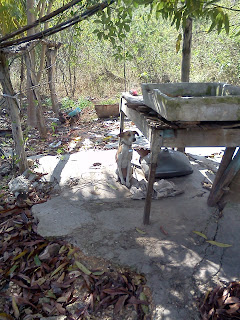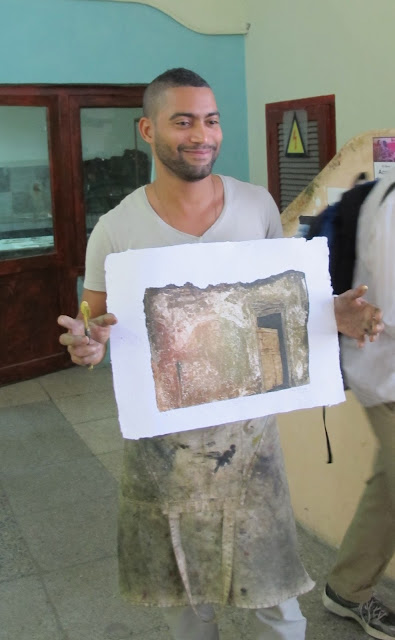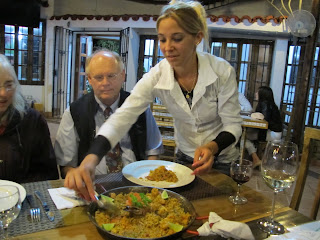Sunday, March 3
Finally, full sun! Our
morning mission was a nature walk about11 km. east of Playa Giron at the Refugio de Fauna Bermejas where we saw about 40 species of birds.
Two of the really interesting ones were the bee-sized hummingbirds, the smallest know hummer, and a small owl. (Sorry no hummingbird photos, they move way too fast.)
 |
| Margie & Julian birding in Cuba |
Two of the really interesting ones were the bee-sized hummingbirds, the smallest know hummer, and a small owl. (Sorry no hummingbird photos, they move way too fast.)
 |
| Our birding guide Orlando. |
 |
| Fences Alive! |
One of the things that fascinated us as we walked around were the property fences. They were actually vertical stakes supporting the horizontal wire that had sprouted root and were growing. We also saw some fences that were actually tightly pruned cactus, like a hedge.
 |
| Land Crab-Colorful! |
A land crab and a hermit crab were two other
highlights.
 |
| Rustic laundry facilities with dog. |
 |
| Another open air kitchen in Cuba. |
We enjoyed walking through a village and seeing how differently, or the same, the people lived as in the mountains of Mil Cumbres we had visited a few days ago. Still outside kitchens. Very rustic bathrooms and laundry areas too, of course. There were hardly any cars at all in the villages, just a few vintage government farm vehicles. We were interested to see many colorful front gardens and it seems it was a rule that you had to have two comfortable rocking chairs on your front porch. Preferably with a dog sleeping on a mat in front of the door.
 |
| Colorful Cuban home with two rocking chairs on the front porch. |
 |
| Charcoal maker in Cuba. |
It was interesting to see a man making charcoal in the traditional way in the village.

We had a nice lunch at a roadside spot, the café at La Cueva de los Pesces which, in addition to tilapia, had some very good squid (still white, though). The Cueva is a flooded tectonic fault or cenote, about 70m deep, where we watched intrepid visitors and locals snorkel in the sea water. The water in the Bay of Pigs was brilliantly blue and beautiful. We took turns posing with such a beautiful background.
 |
| Intrepid swimmers in the Cueva de los Pesces. |

We had a nice lunch at a roadside spot, the café at La Cueva de los Pesces which, in addition to tilapia, had some very good squid (still white, though). The Cueva is a flooded tectonic fault or cenote, about 70m deep, where we watched intrepid visitors and locals snorkel in the sea water. The water in the Bay of Pigs was brilliantly blue and beautiful. We took turns posing with such a beautiful background.
 |
| Nora and Bill at the Bay of Pigs. |
 |
| Steve studying 7 year-old Cuban rum. |
After our trekking, we repaired to the hotel, and went back to see if
the beach, and even more importantly, the little bar thereupon, was still there. Not sure we had learned everything we needed
to know about rum, we furthered out studies, led by our guru, Steve.
Some of the more intrepid in our group again enjoyed a swim in the warm, salty water with the soft sand underfoot.
Dinner was at the hotel, and the very good trio again entertained us. Note the interesting pottery on display in the background behind the musicians. Art and music were everywhere in Cuba.
Monday, March 4
 |
| Hotel Playa Larga on the Bay of Pigs, Cuba |
One last peaceful beachfront morning in Playa Largo, then it was time to head back to Habana. En route, we
stopped to see the KORIMACAO Project near Playa Larga. This is not like art schools we know. Founded in 1992, it teaches art, music and
dance, and is self- contained, in that they do all of their own production
work, including costuming, stage and
set-design.
The students have to be at
least 17, but with no upper limit, and those that study year-round receive a
modest salary. In turn, they go to rural
communities that would never see live performances of this quality. The dance was good, but we was really
impressed by the jazz ensemble, which included an outstanding saxophonist. To hear this group and learn more about the
school, we direct you to a good blog written by Jeannine Barone, about the project with an excellent video clip of the jazz ensemble.
 |
| Design students at KORIMACAO showing off their work. |
 |
| Musicans and view from La Moneda |
 |
| Havana Club Cuban Rum |
We returned to Habana to check back into the Palacio de SanFelipe; it was like coming home!. For lunch, we decided to visit
the paladar La Mondea Cubana, just off the Plaza de la Cathedral. This private restaurant was up a flight of stairs, but
the climb rewarded us with some great city views. It was a nice way to begin to close our trip,
for we overerlooked rooftops and recognize sights that we had seen. We shared three platos of shrimp, seafood and mixed meats,
The soup was fabulous with a pesto oil decoration. A welcome treat after the plain country food we had been enduring for several days.
 |
| Delicious soup at La Mondea paladar in Havana |
The soup was fabulous with a pesto oil decoration. A welcome treat after the plain country food we had been enduring for several days.
 |
| Castillo de la Real Fuerza weathervane called La Giralda |
 |
| Castillo de la Real Fuerza, Habana, Cuba |
We ordered mojitos and the
server proudly showed us the small figure Cubans call La Giralda, based on the figure crowning La Giralda in Seville, Spain, on the Havana Club logo of our
glasses, was to be seen in real life on top of the west tower of the Castillo de la Real Fuerza, in view of the deck where we were dining. The Castillo is believed to be the oldest
colonial fort in the Americas De
Soto
 |
| Taller Experimental de Grafica |
After a pleasant lunch, accompanied, of course, by live music, we and headed back to Plaza de la Catedral, where at the far corner there was a graphics workshop called Taller Experimental de Grafica, which we learned is the foremost printmaking studio in
About 14 graphic artists work and show there, and we chose
a wonderful print by Desbel Alvarez Guerrero called "My City".
 |
| Desbel Alvarez Gurrreo with the lithograph he made for us "My City" |
At the time, Joan remarked that the framing back home would cost 10x as
much as the print and sure enough, she was right. We wish we could have given the artist the
framing price, but we look forward to our framed print by Desbel and we know it
will bring back pleasant memories of Cuba
Later in the day, we joined our Philadelphia
friends and Cuba
 |
| Before we'd tried the Best hot chocolate Ever at the Museo de Chocolate! |
Dane also bought a few wrapped bars to take
home with us. A Swiss friend of ours,
Beatrice, told us long ago that when travelling in a foreign land it is always
good to have a few pieces of “emurgency (her pronunciation) chocolate on hand –
just in case. Solid advice, make sure
you pronounce it the way Beatrice did.
That evening we boarded our bus and drove through Habana,
first to an interesting organization called Cabildo Quisicuaba, which helps people with AIDS and gay and transgender Cubans.
It was in a poor and run-down neighborhood, and while we were waiting, we enjoyed watching an impromptu baseball game being played on the site of a leveled building – the boys were having great fun with a makeshift ball and bat. The director gave us a very interesting talk about the herbal medicines used in the Afro-Cuban religion. We were not allowed to take pictures, but it was floor-to-ceiling decoration, covering a wide range or belief systems and using folk art to toys to make a point. It was an eyeful.
 |
| Baseball on a corner lot in Habana, Cuba. Third base was the old blue truck. |
It was in a poor and run-down neighborhood, and while we were waiting, we enjoyed watching an impromptu baseball game being played on the site of a leveled building – the boys were having great fun with a makeshift ball and bat. The director gave us a very interesting talk about the herbal medicines used in the Afro-Cuban religion. We were not allowed to take pictures, but it was floor-to-ceiling decoration, covering a wide range or belief systems and using folk art to toys to make a point. It was an eyeful.
 |
| Pam & Steve look forward to their seafood paella at La Campana |
The off to a different neighborhood to Campana Restorante, a private restaurant in an upscale neighborhood of
Habana. The building had been
a very nice house at one time,with even a swimming pool. This was our farewell dinner, and here we
were able to break free of the famous offering trio (chicken, pork, fish, in case you forgot). We were all attracted to the paella dishes on the menu. (We know! Rice,
chicken, pork, fish but at least in a different format!)
 |
| Chicken and pork Paella at La Campana Restaurant, Havana, Cuba |
The mojitos
weren’t bad either. The ride back to the
hotel took us through neighborhoods
where we could see some of the grand art-deco architecture.
If we go back to Cuba Cuba has a lot to offer, now all we have to do
is convince the US Government to raise the embargo so the poor people of Cuba
 |
| Our agreeable, interesting group in Cuba, February-March, 2013, with Yuli and Abel, our wonderful guide and driver |




No comments:
Post a Comment